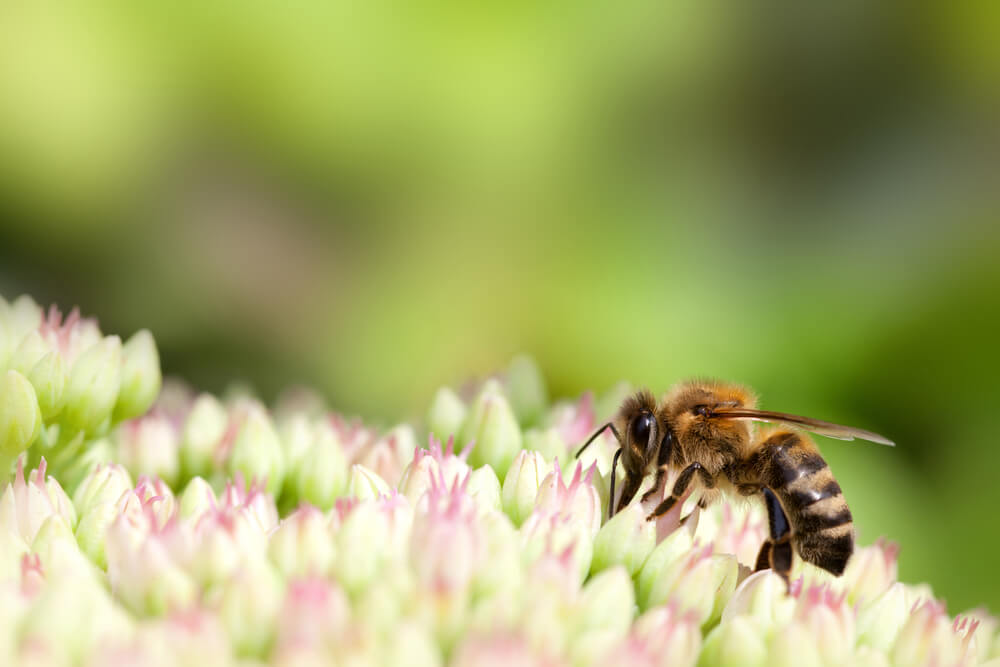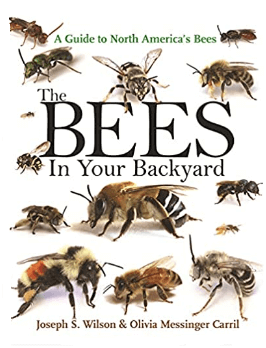Table of Contents:
What Bees Don’t Sting?
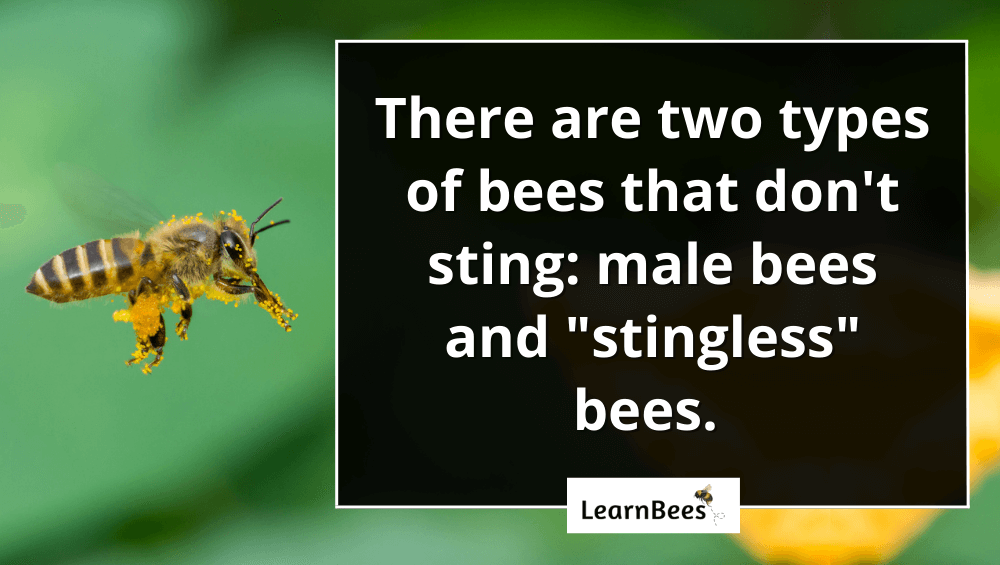
There are two types of bees that don’t sting:
- Male bees
- Stingless bees
For starters, male bees don’t sting because they don’t have a stinger. Stingers are modified egg-laying organs, so only female bees have them. This means that if you’ve ever been stung by a bee, it was a female.
The same is true for wasps.
Only female wasps have stingers. Male wasps do not.
This is because male bees and wasps have an entirely different role than females. They don’t clean, build, or protect the hive. Their sole purpose is to mate with females to ensure the future generation of bees and wasps.
That’s it.
Additionally, there is a group of bees called “stingless bees.” As their name implies, stingless bees don’t sting. There are several hundred species of stingless bees, and they’re found in tropical climates all over the world.
Stingless bees are typically smaller than the honeybees we’re used to seeing in North America.
But here’s the thing:
Female stingless bees do have stingers. However, their stingers are small and weak, making them unsuitable for protection.
So that brings us to our next question…
How Do Bees That Don’t Sting Defend Themselves?
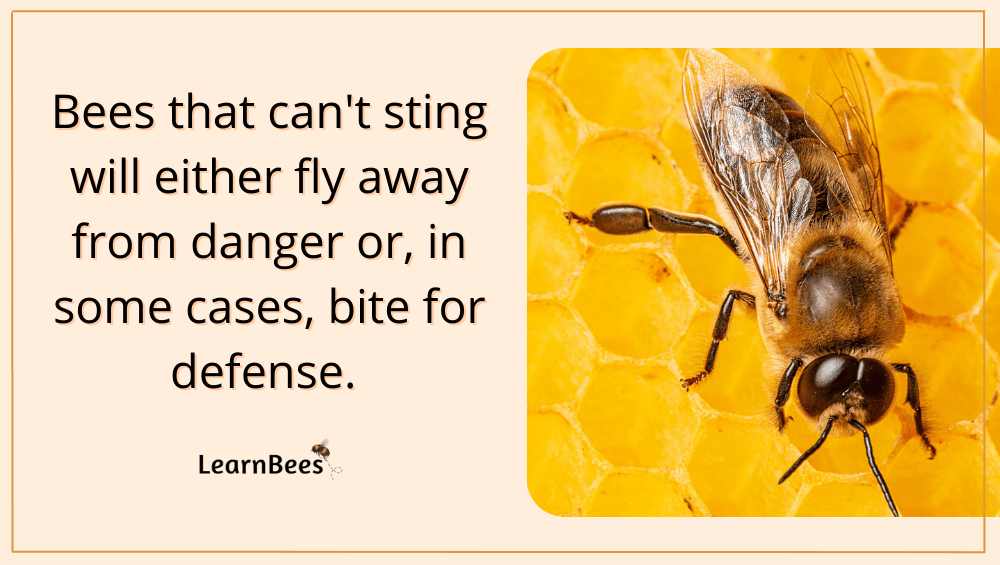
Good question.
Male bees can’t defend themselves. Their best defense is to fly away from trouble or rely on the female colony members to protect them.
For example:
Honeybees live in large colonies with as many as 50,000 bees. The queen bee is responsible for laying eggs and the male bees are responsible for mating.
As for the female worker bees?
They’re responsible for almost everything else, including:
- Defending the colony from predators
- Gathering pollen and nectar
- Making beeswax to build honeycomb
- Cleaning and tending to the queen bee
- Raising the baby bees
As such, male honeybees rely on the female worker bees for protection.
But what about stingless bees?
As mentioned, stingless bees have tiny stingers that aren’t useful. However, many species of stingless bees rely on biting for defense. They secrete formic acid when they bite, creating small blisters similar to ant bites.
Which Bee Does Not Retain its Stinger?
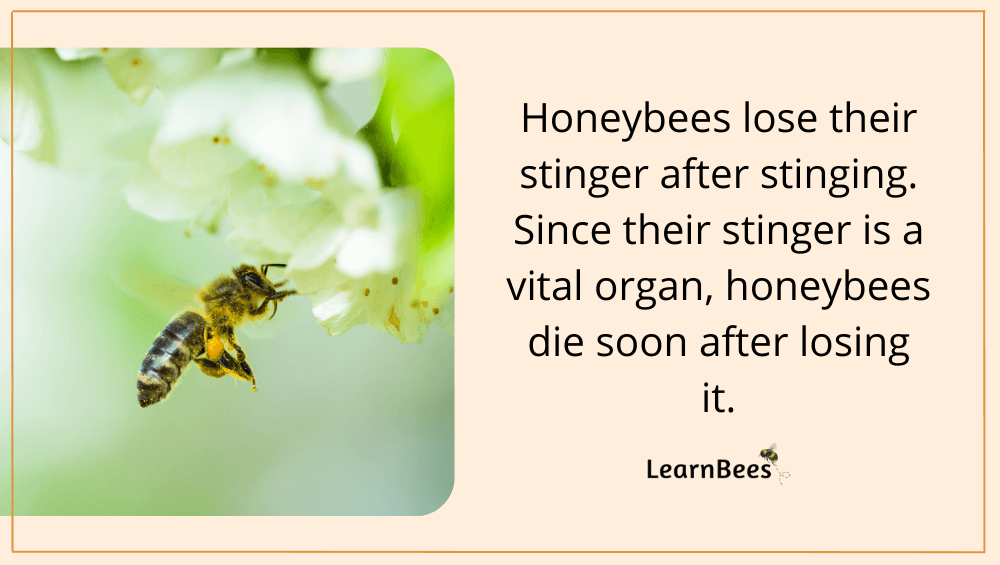
Honeybees lose their stinger after stinging humans or mammals. This is because they have barbed stingers that “hooks” into our skin. When the bee tries to fly away, they leave their stinger behind.
And unfortunately for them?
This leads to their death.
Stingers are a vital organ that honeybees can’t live without. When a honeybee loses its stinger, it essentially rips out the bee’s “guts.” As such, honeybees die within a few minutes of losing their stinger.
But here’s the interesting part:
If a honeybee keeps its stinger, it can survive. That said, it can take a honeybee two to three minutes to wiggle itself free from human skin without losing its stinger.
Here’s a video demonstrating that:
So the moral of the story?
If you give the honeybee a few minutes to break loose after stinging, it can live to see another day.
FAQs on “What Bees Don’t Sting?”
- Do all types of bees sting?
- Do bees always sting?
- What bees don’t have stingers?
- Which bee loses its stinger?
- Which bumble bee does not sting?
- Can fuzzy bees sting?
- Do drone bees sting?
- How do you make sure bees don’t sting you?
- Do some bees bite instead of sting?
- Can carpenter bees sting you?
- Do green bees sting?
- Is a bumblebee sting worse than a honey bee?
- What to do if a bumblebee stings you?
- Do the really big bumble bees sting?
- Can mason bees sting?
Do all types of bees sting?
No, not all types of bees sting.
Remember:
Male bees aren’t equipped with stingers like female bees are. Female bees can sting because stingers are modified egg-laying devices. Male bees don’t lay eggs, so they don’t need stingers.
Additionally, there is a group of bees called “stingless bees,” which account for around 550 described species. As the name suggests, stingless bees don’t sting because their stingers are too tiny to be useful.
Stingless bees live in tropical and sub-tropical climates. For example, the sugarbag bee is a stingless bee commonly found in Australia.
—> Go back to the FAQs on “What Bees Don’t Sting?”
More to Explore:
- What Does a Bee Sting Look like?
- Do Bees Die When They Sting?
- The Best Essential Oils for Bee Stings
Do bees always sting?
No, you might be surprised to learn that most bees are calm and gentle-natured. They get a bad rap because they use stingers as a defense mechanism.
But ultimately, bees won’t go out of their way to sting you. Bees only sting humans or animals when they feel threatened. For example, if you accidentally get too close to their hive, they might sting you to defend their nest.
Remember:
Bees have to be territorial over their hive because they have many predators. For instance, skunks, raccoons, honey badgers, and bears are natural predators of honeybee hives.
In fact, a grizzly bear can destroy an entire honeybee hive in a matter of seconds.
So when you think of it that way, it’s understandable that bees must be protective of their hives.
—> Go back to the FAQs on “What Bees Don’t Sting?”
More to Explore:
What bees don’t have stingers?
“What type of bees don’t sting?” is a common question we get.
There are thousands of different bee species, many of which can sting.
However, the two types of bees that can’t sting are male bees and stingless bees. Stingless bees are a group of bees that account for around 550 described species. As the name suggests, stingless bees don’t sting because their stingers are tiny and useless.
Male bees don’t sting because stingers are actually modified egg-laying devices. Since male bees don’t lay eggs, they don’t have stingers.
This means male bees must fly away from threats instead of stinging.
—> Go back to the FAQs on “What Bees Don’t Sting?”
More to Explore:
- Do Carpenter Bees Sting?
- How to Remove a Bee Stinger Stuck Under Skin
- The 10 Best Flowering Trees for Bees
Which bee loses its stinger?
Honeybees.
When a honeybee stings humans or animals, the stinger gets lodged in the skin. As the honeybee tries to fly away after stinging, the stinger, along with a venom sac, gets ripped out of the bee’s abdomen.
This process is fatal for honeybees because they die soon after losing their stingers.
Bumblebees, on the other hand, can sting multiple times because their stingers are smooth and don’t get hooked into the skin.
—> Go back to the FAQs on “What Bees Don’t Sting?”
More to Explore:
Which bumble bee does not sting?
People often ask, “Do bumble bees sting you?”
The answer is yes. Female bumblebees can sting.
Remember:
Only female bees can sting. Male bees cannot. This is true for all bee species, including mason bees, honeybees, carpenter bees, and so on.
Male bees cannot sting because they don’t have stingers. Stingers are modified egg-laying organs, so only female bees have them.
Male bees mostly have one job: to mate with virgin queens. This doesn’t mean that male bees are unimportant. It just means that nature has designed a different job for them.
—> Go back to the FAQs on “What Bees Don’t Sting?”
More to Explore:
Can fuzzy bees sting?
Here’s the thing:
The term “fuzzy bee” isn’t specific. Hundreds – maybe even thousands – of bee species are fuzzy. For instance, both bumblebees and mason bees can be fuzzy.
With that said, most people are referring to bumblebees when they say “fuzzy bees.” This is because bumblebees are common in North America. They’re also large bees, allowing them to be easily spotted by people.
So do fuzzy bumblebees sting?
Yes, bumblebees can sting when they feel seriously threatened. But the good news is that bumblebees are usually very gentle. As long as you don’t poke around their hive or try to grab them, you should be fine.
—> Go back to the FAQs on “What Bees Don’t Sting?”
More to Explore:
Do drone bees sting?
No, drone bees don’t sting. Drone bees are male bees that don’t have stingers. Stingers are actually modified egg-laying organs, and since male bees don’t lay eggs, they also don’t have stingers.
This means that drone bees can’t sting humans or animals. However, they’re not entirely useless in the hive. Drone bees are necessary to ensure the future generation of bees.
Without drone bees, there would be no new queens and no new hives. So while they may not have stingers, drone bees are still an important part of the hive.
—> Go back to the FAQs on “What Bees Don’t Sting?”
More to Explore:
How do you make sure bees don’t sting you?
The best way to avoid getting stung by bees is to leave them alone. Don’t try to swat or grab them, and don’t go near their hive.
It’s also smart to be aware of any bee hives on your property. If they are within 50 feet of humans or animals, you can consider calling a local beekeeper to remove the hive safely.
If you’re outside, wear light-colored clothing to avoid attracting bees. And if you’re inside, keep windows and doors shut, so bees don’t come inside.
Bees are actually quite gentle creatures. They only sting humans or animals when they feel seriously threatened. So as long as you’re not trying to harm them, there’s no need to be fearful of bees.
—> Go back to the FAQs on “What Bees Don’t Sting?”
More to Explore:
Do some bees bite instead of sting?
Yes, some bees do bite instead of sting. For example, stingless bees can’t use their stinger for defense because it’s too small to be effective.
So instead, they often resort to biting predators for protection. Stingless bees release formic acid when they bite, which can result in tiny blisters. Formic acid is the same secretion that ants release when they bite.
—> Go back to the FAQs on “What Bees Don’t Sting?”
More to Explore:
- Ground Bees: Are They a Threat to Your Yard?
- Wasps vs. Honeybees: Are They Different?
- Do Bumble Bees Bite?
Can carpenter bees sting you?
Yes, but only female carpenter bees can sting. Male carpenter bees don’t have stingers, so they can’t sting humans or animals.
Female carpenter bees can sting, but they typically only do so if they feel threatened. For instance, if you try to swat at them or grab them, they may sting you in self-defense.
Carpenter bees are actually quite gentle by nature. So as long as you don’t try to harm them, you shouldn’t have anything to worry about.
—> Go back to the FAQs on “What Bees Don’t Sting?”
More to Explore:
- Do Carpenter Bees Pollinate?
- How Long Do Bumble Bees Live?
- Honeybees vs. Bumblebees: How Do They Compare?
Do green bees sting?
We often get asked this, along with many other questions such as:
Can fat bees sting? Can little bees sting? Can European bees sting? Can black bees sting?
The answer is that most bees can sting as long as they’re female bees that don’t fall into the stingless bee category. Stingless bees only make up around 550 different species. There are over 20,000 bee species in total.
—> Go back to the FAQs on “What Bees Don’t Sting?”
More to Explore:
Is a bumblebee sting worse than a honey bee?
Not necessarily. In most cases, a honeybee’s and bumblebee’s sting can feel very similar. However, bumblebees can sting multiple times because their stinger isn’t barbed like honeybees.
This means that the bumblebee can pull away from its victim without detaching its stinger. In contrast, a honeybee’s stinger gets stuck in the skin of its victim when it tries to sting them.
This kills the honeybee because its stinger and digestive tract are torn out in the process.
—> Go back to the FAQs on “What Bees Don’t Sting?”
More to Explore:
What to do if a bumblebee stings you?
If you’re allergic to bee stings, the best thing to do is seek medical help immediately. For everyone else, the pain of a bumblebee sting will typically go away within a few hours.
You might experience some slight redness and swelling at the sting site area. If this happens, you can apply a cold compress to the area to help reduce the swelling. For most people, any bee sting symptoms should disappear within 24 hours.
—> Go back to the FAQs on “What Bees Don’t Sting?”
More to Explore:
Do the really big bumble bees sting?
Yes, bumblebees can sting if they feel threatened. The size of a bumblebee doesn’t determine whether or not it can sting you.
That said, sometimes bumblebees are mistaken for carpenter bees. Carpenter bees and bumblebees are both large and look alike from a distance. Carpenter bees can also sting like bumblebees.
However, both bumblebees and carpenter bees are mostly gentle bees that want to be left alone. They don’t go out of their way to sting people.
—> Go back to the FAQs on “What Bees Don’t Sting?”
More to Explore:
- Do All Bees Sting?
- What’s the Difference Between Wasps, Hornets, and Bees?
- Bee Antennae: Interesting Facts & Uses
Can mason bees sting?
Yes, female mason bees can sting if they feel threatened. Male mason bees don’t have stingers, so they can’t sting humans or animals.
But the good news?
Mason bees are solitary bees that don’t live in hives. They also don’t make honey, so they aren’t defensive by nature. This is why people use mason bee houses around their homes to attract mason bees to their gardens.
In contrast, honeybees are more territorial because they must defend their colony and honey.
